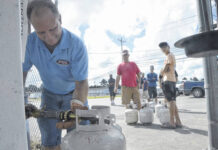
Beth Markesino, founder of North Carolina Stop GenX Now in Our Water, and a group of volunteers display posters and flags during a PFAS protest rally she co-organized outside the Chemours’ Fayetteville Works facility in November. Since 2017, Markesino has organized approximately 24 protest rallies at this location.
Will Atwater | NC Health News
Activists breathe sigh of relief, but say more needed to address PFAS crisis
Late last month, the U.S. Environmental Protection Agency wrote to North Carolina Gov. Roy Cooper to say that it had rescinded permission for Chemours to import GenX from its Dordrecht Works facility in the Netherlands.
As reported initially in NC Newsline, the EPA had given Chemours tentative permission to import up to 4 million pounds of Gen X-contaminated waste from the Netherlands to its Fayetteville Works facility on the border of Cumberland and Bladen counties. But the EPA reversed its decision, citing calculation errors by Chemours over the amount of GenX waste that would be shipped, according to the agency’s letter to Cooper.
The announcement is a small win in North Carolina environmental advocates’ ongoing battle to force Chemours to take responsibility for contaminating the Cape Fear River with GenX compounds, which have spread to the soil and drinking wells in the region.
“I am grateful to the EPA, Gov. Cooper, local activists and our friends in the Netherlands for their quick call to action,” said Beth Markesino, founder of North Carolina Stop GenX Now in Our Water, an environmental advocacy group working to raise awareness about PFAS contamination in the Cape Fear region. “The EPA rescinding their approval of Chemours importing waste material containing GenX shows their commitment to preventing PFAS-attributed illnesses in North Carolina.”
“[When] you hear about the problems you have with Chemours in North Carolina, it’s almost shocking compared to what is already restricted in the Netherlands,” said Eva van Esch, member of the Party for the Animals in the Netherlands. “We’re lucky that we already have these kinds of restrictions.”
Mike Watters, founder of the advocacy group Gray’s Creek Residents United Against PFAS in our Wells and Rivers, was also pleased with the EPA’s announcement but recognizes that the battle is not over.
“This was fantastic news, [but] as always there is much more to the story,” Watters said.
For some, like Leland resident Francine Ameri, the news that Chemours will not be allowed to import GenX waste doesn’t go far enough to address her concerns.
One thing that worries Ameri the most is how to prevent her elderly mother, who is ill and lives with her, from being exposed to PFAS compounds.
“How do I explain to someone with dementia that they can’t drink the water in the house?” she asked.
It’s personal
There are roughly 15,000 to 20,000 unique per- and polyfluorinated substances (PFAS) in the environment, according to experts. PFAS are present in multiple products to help make them slippery and resistant to oils, water and solvents, including some cosmetics and apparel, microwave popcorn wrappers, dental floss, firefighting gear and some firefighting foams.
PFAS are associated with adverse health effects such as increased cholesterol levels, kidney and testicular cancer, pre-eclampsia in pregnant women and decreased vaccine response in children, among other conditions.
For Markesino and Watters, as well as some other advocates who are demanding that Chemours be held liable for Gen X emissions that have contaminated the air, soil and water in the Cape Fear region, this fight is personal.
In 2016, Markesino gave birth to her son Samuel, whose kidneys, bladder and bowels did not develop. He died 24 weeks later, she said. In 2017, news broke that GenX compounds were found in the Cape Fear River.
“When I heard about the Gen X contamination, I wondered if the Gen X [chemicals] I was drinking in my water contributed to the loss of my son,” Markesino said. “The last six years, I have been a strong advocate working to find research and information about the harmful effects of these chemicals.”
Markesino and Watters are a part of the GenX Exposure Study, which is collecting blood from people potentially exposed to the compounds in the Cape Fear Basin and elsewhere. Watters is being treated for polycythemia vera, a blood disease that causes bone marrow to overproduce red blood cells. Watters said his treatment for the disease requires him to “give a pint of blood every six weeks” to keep his red blood cell levels down, he said.
“I’ve got [an illness] that is most likely tied to PFAS contamination.”
A lack of transparency
Motivated by personal experiences, Markesino and Watters have worked together to share what they’ve learned about PFAS with the broader community.
In 2017, Markesino organized the first PFAS rally in front of the Chemours Fayetteville Works facility on the Bladen County side of the property.
“When I had the first protest, it was just me and my daughter, and she was just 3 at the time, and we just drove up to the [Chemours] gate and talked to security and other individuals that work here … and nobody came out for the protest,” Markesino said.
Watters and his wife joined the next protest, and since 2017, the two have partnered to hold roughly 24 protest rallies at the site. The rallies usually correspond with a new development in the saga of PFAS in the Cape Fear region.
Markesino’s and Watters’ organizations co-sponsored the most recent rally on Nov. 18 to spread the word about the PFAS waste that Chemours planned to start importing from the Netherlands on Dec. 1, which the EPA has since disallowed.
Through the rallies and other community service endeavors, Markesino and Watters answer people’s questions about the GenX Exposure Study, class-action lawsuits and more.
Having people to turn to for assistance with the numerous questions that can arise related to PFAS is crucial for people like Ameri and others, who say they can become overwhelmed as they try to navigate mountains of information to determine what’s best for them. There are multiple decisions to be made regarding, for instance, whether installing a granular activated carbon system or connecting to the municipal water supply is the best solution for dealing with a PFAS-contaminated drinking water well.
In a recent social media thread hosted by Gray’s Creek, Ameri shared her frustration about what she considers a lack of transparency around PFAS contamination in the local community. She wrote in part:
“I want everyone in and moving to North Carolina to know what is going on,” she said. “I want warning signs put up at public waterways. I want real estate agents who aren’t transparent with new clients about the water to be able to be privately sued for damages.”
“I want Chemours to stop premeditating my death,” she later added. “I invested in my property over two and a half decades ago in Leland, not Flint, Michigan. Yes, I want what I deserve, but I also want everyone to be forewarned before they move their families here to die.”
Markesino and Watters, like other environmentalists across the country, are waiting on an announcement by the EPA regarding new PFAS maximum contamination levels, which may inspire the next PFAS rally at the Chemours’ Fayetteville Works facility.
The agency is expected to announce new PFAS MCL regulations sometime in December.








